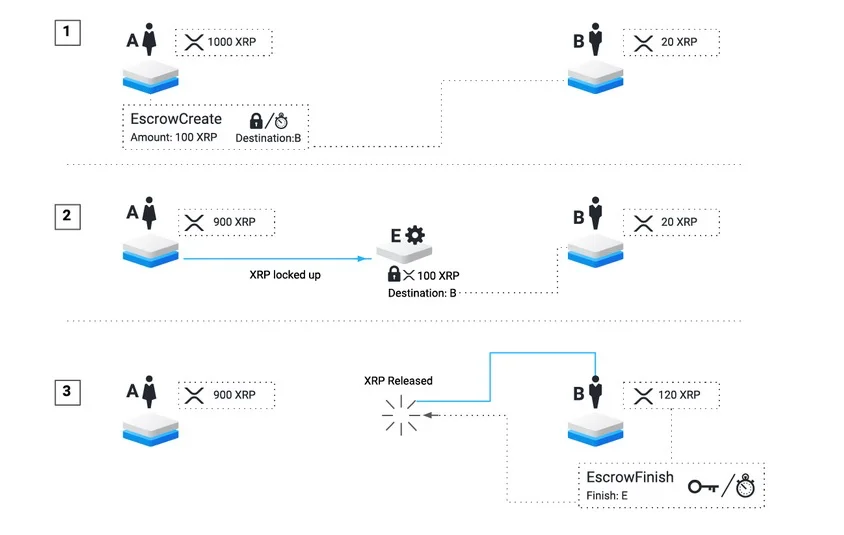Gain deep insights into how XRP works and its pivotal role within Ripple’s ecosystem.
In the world of cryptocurrencies, the conversation is typically dominated by giants such as Bitcoin and Ethereum. However, it’s essential not to lose sight of other influential players in the arena, such as XRP. To shine a light on this dynamic digital asset, this article provides an exhaustive exploration of how XRP works. We’ll delve into its genesis, unique functionalities, and vital role in the Ripple ecosystem.
The Genesis of XRP: Setting the Record Straight
Contrary to a widely held misconception, Ripple did not create XRP. The digital currency was developed by David Schwartz, Arthur Britto, and Jed McCaleb. These innovative pioneers later established the company Ripple. This distinction is critical, particularly for those trying to unravel the intricacies of how XRP works.
The creators of XRP envisioned a cryptocurrency that could facilitate swift, low-cost international transactions. This vision positioned XRP as a valuable asset in the ever-evolving financial industry.
The Relationship Between XRP, Ripple, and The Ripple Network
To fully comprehend how XRP works, it’s crucial to grasp its relationship with Ripple and the Ripple Network. Ripple, the company, uses XRP, the cryptocurrency, within its payment ecosystem.
The Ripple Network, also referred to as RippleNet, is a global network of institutional payment providers. These include entities like banks and money services businesses. These entities use Ripple’s technology to offer frictionless, real-time cross-border transfers.
Deciphering the Mechanism of XRP
The mechanism that governs how XRP works is significantly different from most other cryptocurrencies. Bitcoin uses a protocol known as Proof of Work (PoW), and Ethereum is in the transition process to Proof of Stake (PoS). In contrast, XRP uses a consensus algorithm to validate transactions.
XRP’s consensus protocol operates through a network of independent validating nodes. These nodes collectively agree on the order and authenticity of transactions. This process results in quicker transaction confirmations without the associated high energy costs of PoW.

XRP’s Vital Role in the Ripple Ecosystem
One key aspect of understanding how XRP works is to appreciate its role within the Ripple ecosystem. XRP functions as a bridge currency within RippleNet.
When banks or financial institutions want to transfer money, they convert the funds into XRP. The XRP is then sent across the Ripple network. On reaching its destination, it’s converted back into the recipient’s preferred currency. This method significantly reduces both the cost and time involved in international money transfers.
Unique Features of XRP: Setting it Apart
Understanding how XRP works means recognizing its distinctive characteristics. In contrast to Bitcoin, which miners must extract using computational power, all XRP coins were pre-mined. The creators of XRP minted a finite supply of 100 billion coins.
Another unique feature of XRP is its ‘burn’ rate. Every time a transaction takes place, a small amount of XRP is ‘burned’ or destroyed. This burning reduces the overall supply and theoretically increases the value of the remaining XRP.
XRP: Paving the Way for Efficient Transactions
The primary objective of XRP is to act as a catalyst in international money transfers, making the process more efficient and less costly. Therefore, anyone interested in the fintech space or future of digital transactions would do well to understand how XRP works.
What the Future Holds for XRP
Given its potential to revolutionize international transactions, XRP’s future looks bright. As more and more financial institutions recognize and embrace Ripple’s technology, the demand for XRP could see a significant increase. This rise in demand could consequently increase the value of XRP, thus heightening its role within the world of digital currencies.
The Utility of XRP
While XRP’s primary utility is to facilitate international transfers, it’s not the only function it serves. XRP can also be used as a typical cryptocurrency — for investment purposes, or as a medium of exchange where accepted. Additionally, developers can create decentralized apps (dApps) on the XRP Ledger sidechains, extending its utility beyond just payments.
Investment in XRP: A Consideration
Understanding how XRP works is particularly vital for potential investors. Due to its unique features, XRP presents both opportunities and challenges for investors. On the one hand, its growing adoption, finite supply, and utility in the Ripple ecosystem make it an attractive asset. On the other hand, its price is subject to volatility common to cryptocurrencies, and potential regulatory challenges could impact its future.
How to Buy and Store XRP
Purchasing XRP is straightforward. You can buy XRP on several cryptocurrency exchanges using fiat currencies or other cryptocurrencies, depending on the platform. As for storage, it’s advisable to use a digital wallet rather than keeping your XRP on an exchange. Wallets range from online options to hardware wallets, which offer a higher security level.
Conclusion
In the quest to understand how XRP works, it becomes evident that this digital currency is not just another cryptocurrency. It’s an innovative technology that seeks to change the way we conduct cross-border transactions, making them faster, more affordable, and transparent.
As we continue to see an accelerated shift towards a digital, interconnected world, technologies like XRP will play a critical role in shaping the future of finance. Whether you’re a budding investor, a financial institution, or simply a fintech enthusiast, understanding how XRP works can provide insightful perspectives on the unfolding future of digital transactions.